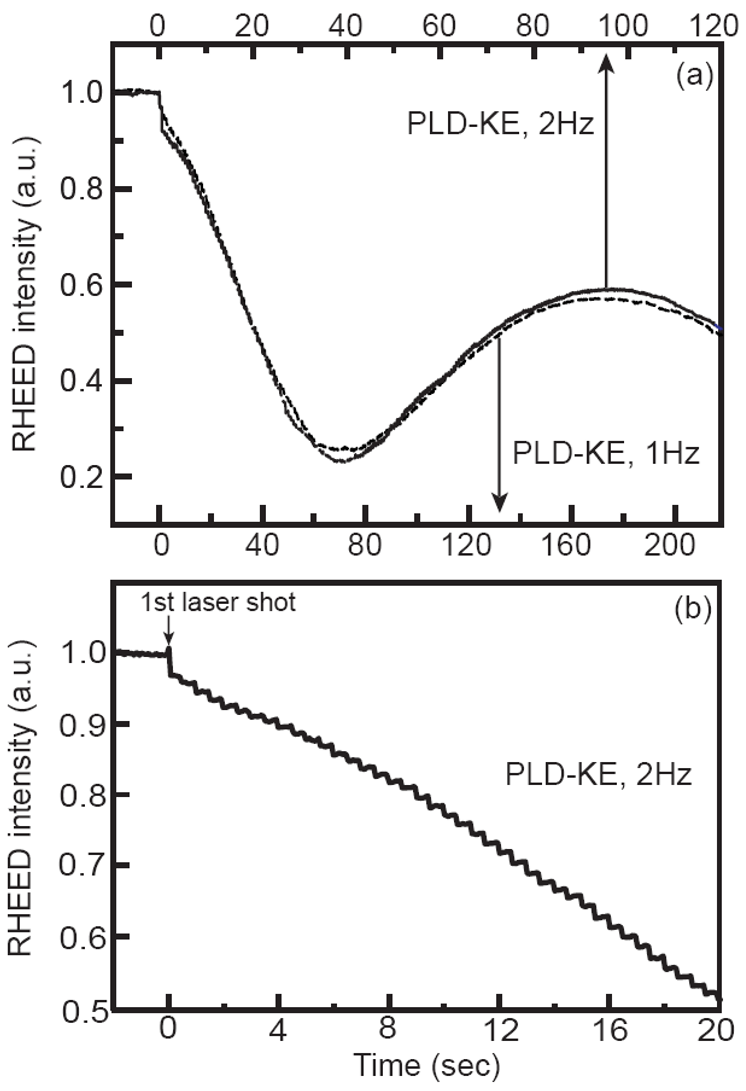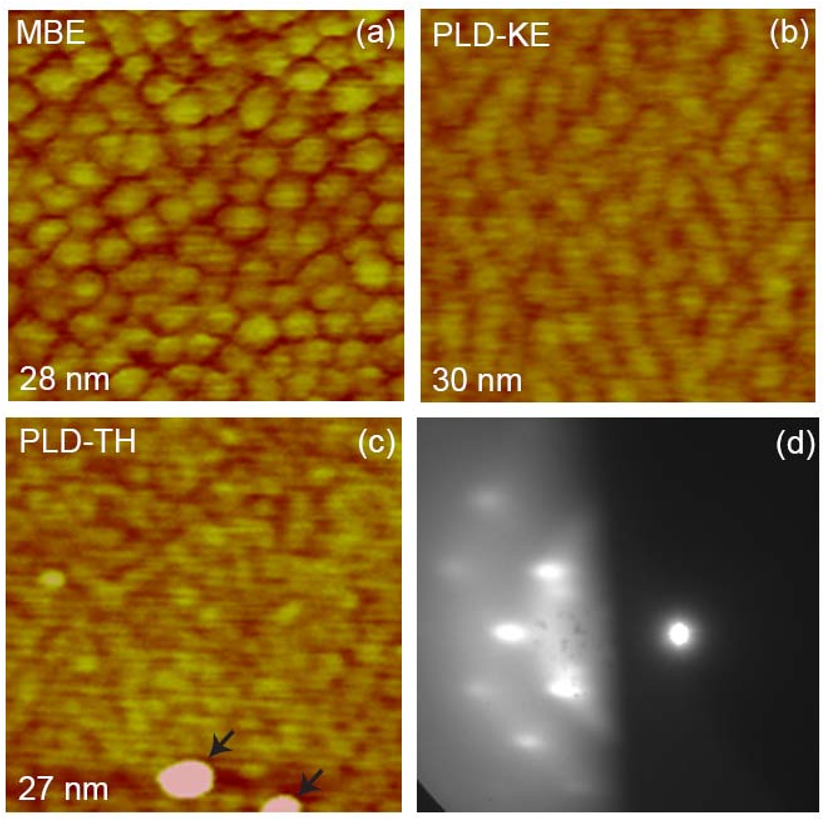Kinetic-energy induced smoothening and delay of epitaxial breakdown in pulsed-laser deposition
TL;DR: In this paper, the effect of kinetic energy of depositing species from flux pulsing during pulsed-laser deposition (PLD) on surface morphology evolution of Ge(001) homoepitaxy at low temperature was isolated.
Abstract: We have isolated the effect of kinetic energy of depositing species from the effect of flux pulsing during pulsed-laser deposition (PLD) on surface morphology evolution of Ge(001) homoepitaxy at low temperature $(100\phantom{\rule{0.2em}{0ex}}\ifmmode^\circ\else\textdegree\fi{}\mathrm{C})$. Using a dual molecular beam epitaxy (MBE) PLD chamber, we compare morphology evolution from three different growth methods under identical experimental conditions except for the differing nature of the depositing flux: (a) PLD with average kinetic energy $300\phantom{\rule{0.3em}{0ex}}\mathrm{eV}$ (PLD-KE); (b) PLD with suppressed kinetic energy comparable to thermal evaporation energy (PLD-TH); and (c) MBE. The thicknesses at which epitaxial breakdown occurs are ranked in the order $\mathrm{PLD}\text{\ensuremath{-}}\mathrm{KE}g\mathrm{MBE}g\mathrm{PLD}\text{\ensuremath{-}}\mathrm{TH}$; additionally, the surface is smoother in PLD-KE than in MBE. The surface roughness of the films grown by PLD-TH cannot be compared due to the early epitaxial breakdown. These results demonstrate convincingly that kinetic energy is more important than flux pulsing in the enhancement of epitaxial growth, i.e., the reduction in roughness and the delay of epitaxial breakdown.
Figures (3)

Fig. 4. (a) RHEED specular intensity variations during PLD-KE with 1 Hz (dashed line) and 2 Hz (solid line) of repetition rate while keeping instantaneous flux the same in both cases. Time axes are adjusted such that intensity minima and maxima for both cases are aligned at the same positions on abscissa. (b) First 20 seconds of RHEED intensity variation of PLD-KE with 1 Hz from (a). Modulations from individual laser pulses are visible. 
Fig. 2. (Color online) AFM images of films grown at 100 °C by (a) MBE, (b) PLD-KE, and (c) PLD-TH, and (d) RHEED pattern taken from surface shown in (c). Scan size and vertical scale of (a) – (c) are 0.25 x 0.25 μm2 and 5 nm, respectively. Thickness of films in (a) – (c) is shown in the left bottom corner of each image. 
Table I. Epitaxial thickness of PLD-KE, PLD-TH, and MBE at 100 °C and 150 °C. In the case of PLD-KE, the thickest samples – 270 nm at 100 °C and 410 nm at 150 °C – are still fully epitaxial.
Citations
More filters
TL;DR: In this article, the growth and crystallinity of oxide thin films using a physical vapour deposition technique like molecular beam epitaxy (MBE) or pulsed laser deposition (PLD) is influenced by the flux of materials, the kinetic energy of species, and the substrate temperature.
Abstract: The growth and crystallinity of oxide thin films using a physical vapour deposition technique like molecular beam epitaxy (MBE) or pulsed laser deposition (PLD) is influenced by the flux of materials, the kinetic energy of species, and the substrate temperature. PLD is generating on a short time scale (µs) a large flux of materials, species with large kinetic energies (few eV up to several 10 eV), and requires often higher growth temperatures as compared to oxide MBE. Here, we show as a proof of principle that epitaxial TiO2 thin films can be grown on LaAlO3 (001) at a much-reduced deposition temperature of 300 °C by applying a bias voltage with respect to a grounded substrate. The controlled manipulation of ion energies with an applied electric field can allow to bridge the gap in growth conditions between PLD and oxide MBE.
7 citations
TL;DR: In this article, an epitaxial beryllia thin film was grown by pulsed laser deposition on Al2O3(001) and SrTiO3 (111) substrates at growth temperatures of up to about 600°C.
Abstract: Epitaxial beryllia thin films were grown by pulsed laser deposition on Al2O3(001) and SrTiO3(111) substrates. Nearly relaxed epitaxial films were obtained on both substrates at growth temperatures of up to about 600 °C. Crystalline films with expanded lattice parameters were obtained even at room temperature. The maximum growth temperature was limited by a loss of beryllium from the film surface. The volatility of beryllium appeared to be caused by the slow oxidation kinetics at the film surface and the re-sputtering effect of high-energy Be and BeO species in the ablation plume. Time-of-flight plume composition analysis suggested that the target surface became Be metal rich at low oxygen pressures, reducing the growth rate of beryllia films.
5 citations
01 Jan 2022-Journal of Materials Chemistry C. Materials for Optical, Magnetic and Electronic Devices
TL;DR: In this article , a mixed Ar and O 2 atmosphere was used for PLD of ferroelectric HfO 2 films, resulting in fewer defects and an increase of the polarization of around 50% compared to conventional PLD.
Abstract: PLD of ferroelectric HfO 2 done under a mixed Ar and O 2 atmosphere allows the reduction of the PLD plasma energy, resulting in fewer defects and an increase of the ferroelectric polarization of around 50% compared to films grown by conventional PLD.
5 citations
TL;DR: In this article, the influence of surface quality on growth characteristics of NbC/Si multilayers grown on silicon substrates of different roughness has been investigated and it was revealed that the stochastic growth of nbC on rough substrate leads to formation of clusters of varying size depending on initial substrate roughness.
Abstract: NbC/Si multilayers grown on silicon substrates of different roughness have been used to study the influence of surface quality on growth characteristics. Surface morphology of substrate and multilayer film are characterized by topographic measurements using atomic force microscopy (AFM) technique and power spectral density analysis (PSD). Grazing incidence x-ray reflectivity (GIXR) technique in combination with PSD analysis reveals a growth characteristic of multilayer film on substrates of different roughness. It is revealed that the stochastic growth of NbC on rough substrate leads to formation of clusters of varying size depending on initial substrate roughness. Details of growth characteristic are discussed.
4 citations
TL;DR: In this paper, the structure, morphology and optical transmittance spectra of pentacene films on the (glass/ITO) surface were studied using thermal vacuum deposition (TVD) and optical flow spectra analysis.
Abstract: The structure, morphology and optical transmittance spectra of pentacene films on the (glass/ITO) surface were studied. The films were grown by two methods - the thermal vacuum deposition (TVD) and...
2 citations
References
More filters
01 Jan 1994
TL;DR: Pulsed laser deposition of high-temperature superconducting thin films for active and passive device applications is discussed in this article, with a focus on the commercial scale-up of Pulsed Laser Deposition.
Abstract: Partial table of contents: History and Fundamentals of Pulsed Laser Deposition (J. Cheung). Diagnostics and Characteristics of Laser--Produced Plasmas (D. Geohegan). Particulates Generated by Pulsed Laser Ablation (L.--C. Chen). Angular Distribution of Ablated Material (K. Saenger). Film Nucleation and Film Growth in Pulsed Laser Deposition of Ceramics (J. Horwitz & J. Sprague). Processes Characteristics and Film Properties in Pulsed Laser Plasma Deposition (S. Metev). Commercial Scale--Up of Pulsed Laser Deposition (J. Greer). Pulsed Laser Deposition: Future Trends (T. Venkatesan). Comparison of Vacuum Deposition Techniques (G. Hubler). Pulsed Laser Deposition of High--Temperature Superconducting Thin Films for Active and Passive Device Applications (R. Muenchausen & X. Wu). Pulsed Laser Deposition of Metals (J. Kools). Appendix. References. Index.
3,228 citations
TL;DR: In this article, the authors outline the fundamental physics involved and go on to discuss recent experimental findings of pulsed laser deposition, as an alternative to chemical vapor deposition or molecular beam epitaxy.
Abstract: Photons have many advantages for vaporizing condensed systems, and laser vaporization sources have a flexibility not available with other methods. These sources are applied to making thin films in the well-known technique of pulsed laser deposition (PLD). The vaporized material may be further processed through a pulsed secondary gas, lending the source additional degrees of freedom. Such pulsed-gas sources have long been exploited for fundamental studies, and they are very promising for film deposition, as an alternative to chemical vapor deposition or molecular beam epitaxy. The authors outline the fundamental physics involved and go on to discuss recent experimental findings.
722 citations
TL;DR: In this paper, the magnetoresistance peak occurs around the Curie point, whereas for x = 0.5 the onset of magnetoreduction is somewhat below and increases monotonically as.
Abstract: Manganites of the series , with x = 0, 0.1, 0.3, 0.5, 0.7 and 1.0, have been characterized in ceramic form and thin films have been prepared by pulsed laser deposition. Characterization techniques included x-ray diffraction, conductivity and magnetoresistance, magnetization and susceptibility, optical spectroscopy and the Faraday effect. Both the films and ceramics exhibit a maximum low-temperature conductivity at which is coexistent with ferromagnetic order. The negative magnetoresistance effect is qualitatively different for the x = 0.3 and x = 0.5 compositions. For x = 0.3 the magnetoresistance peak occurs around the Curie point, whereas for x = 0.5 the onset of magnetoresistance is somewhat below and increases monotonically as . The applied field appears to modify the magnetic order (on the scale of the spin diffusion length) down to the lowest temperatures for x = 0.5, but for x = 0.3 the ferromagnetic order is essentially complete and collinear below the Curie point.
415 citations
TL;DR: In this article, the dynamics of nanoparticle formation, transport, and deposition by pulsed laser ablation of c-Si into 1-10 Torr He and Ar gases are revealed by imaging laser-induced photoluminescence and Rayleigh-scattered light from gas-suspended 1−10 nm SiOx particles.
Abstract: The dynamics of nanoparticle formation, transport, and deposition by pulsed laser ablation of c-Si into 1–10 Torr He and Ar gases are revealed by imaging laser-induced photoluminescence and Rayleigh-scattered light from gas-suspended 1–10 nm SiOx particles. Two sets of dynamic phenomena are presented for times up to 15 s after KrF-laser ablation. Ablation of Si into heavier Ar results in a uniform, stationary plume of nanoparticles, while Si ablation into lighter He results in a turbulent ring of particles which propagates forward at 10 m/s. Nanoparticles unambiguously formed in the gas phase were collected on transmission electron microscope grids for Z-contrast imaging and electron energy loss spectroscopy analysis. The effects of gas flow on nanoparticle formation, photoluminescence, and collection are described.
318 citations
TL;DR: In this article, the basic principles of nanoparticle synthesis by conventional pulsed laser ablation are described and the theoretical development and analysis of the experimental results are given for condensation, expansion and properties of silicon nanoclusters.
188 citations